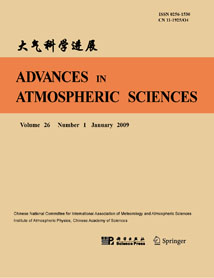| [1] |
Xinyu LI, Riyu LU, Gen LI,
2021: Different Configurations of Interannual Variability of the Western North Pacific Subtropical High and East Asian Westerly Jet in Summer, ADVANCES IN ATMOSPHERIC SCIENCES, 38, 931-942.
doi: 10.1007/s00376-021-0339-0
|
| [2] |
Leying ZHANG, Haiming XU, Ning SHI, Jiechun DENG,
2017: Responses of the East Asian Jet Stream to the North Pacific Subtropical Front in Spring, ADVANCES IN ATMOSPHERIC SCIENCES, 34, 144-156.
doi: 10.1007/s00376-016-6026-x
|
| [3] |
Xiaowei HONG, Riyu LU, Shuanglin LI,
2018: Asymmetric Relationship between the Meridional Displacement of the Asian Westerly Jet and the Silk Road Pattern, ADVANCES IN ATMOSPHERIC SCIENCES, 35, 389-397.
doi: 10.1007/s00376-017-6320-2
|
| [4] |
Peiqun ZHANG, Song YANG, Vernon E.KOUSKY,
2005: South Asian High and Asian-Pacific-American Climate Teleconnection, ADVANCES IN ATMOSPHERIC SCIENCES, 22, 915-923.
doi: 10.1007/BF02918690
|
| [5] |
Lijuan WANG, Aiguo DAI, Shuaihong GUO, Jing GE,
2017: Establishment of the South Asian High over the Indo-China Peninsula During Late Spring to Summer, ADVANCES IN ATMOSPHERIC SCIENCES, 34, 169-180.
doi: 10.1007/s00376-016-6061-7
|
| [6] |
Haoxin ZHANG, Weiping LI, Weijing LI,
2019: Influence of Late Springtime Surface Sensible Heat Flux Anomalies over the Tibetan and Iranian Plateaus on the Location of the South Asian High in Early Summer, ADVANCES IN ATMOSPHERIC SCIENCES, 36, 93-103.
doi: 10.1007/s00376-018-7296-2
|
| [7] |
ZHANG Yaocun, HUANG Danqing,
2011: Has the East Asian Westerly Jet Experienced a Poleward Displacement in Recent Decades?, ADVANCES IN ATMOSPHERIC SCIENCES, 28, 1259-1265.
doi: 10.1007/s00376-011-9185-9
|
| [8] |
ZHOU Ningfang, YU Yongqiang, QIAN Yongfu,
2006: Simulations of the 100-hPa South Asian High and Precipitation over East Asia with IPCC Coupled GCMs, ADVANCES IN ATMOSPHERIC SCIENCES, 23, 375-390.
doi: 10.1007/s00376-006-0375-9
|
| [9] |
Jun LU, Liguang WU, Shunwu ZHOU,
2022: Quantifying the Contribution of Track Changes to Interannual Variations of North Atlantic Intense Hurricanes, ADVANCES IN ATMOSPHERIC SCIENCES, 39, 260-271.
doi: 10.1007/s00376-021-1116-9
|
| [10] |
Xinyu LI, Riyu LU,
2021: Decadal Change in the Influence of the Western North Pacific Subtropical High on Summer Rainfall over the Yangtze River Basin in the Late 1970s, ADVANCES IN ATMOSPHERIC SCIENCES, 38, 1823-1834.
doi: 10.1007/s00376-021-1051-9
|
| [11] |
LI Chaofan, LIN Zhongda,
2015: Predictability of the Summer East Asian Upper-Tropospheric Westerly Jet in ENSEMBLES Multi-Model Forecasts, ADVANCES IN ATMOSPHERIC SCIENCES, 32, 1669-1682.
doi: 10.1007/s00376-015-5057-z
|
| [12] |
LIN Zhongda,
2013: Impacts of two types of northward jumps of the East Asian upper-tropospheric jet stream in midsummer on rainfall in eastern China, ADVANCES IN ATMOSPHERIC SCIENCES, 30, 1224-1234.
doi: 10.1007/s00376-012-2105-9
|
| [13] |
ZHOU Ningfang, YU Yongqiang, QIAN Yongfu,
2009: Bimodality of the South Asia High Simulated by Coupled Models, ADVANCES IN ATMOSPHERIC SCIENCES, 26, 1226-1234.
doi: 10.1007/s00376-009-7219-3
|
| [14] |
LIN Zhongda,
2014: Intercomparison of the Impacts of Four Summer Teleconnections over Eurasia on East Asian Rainfall, ADVANCES IN ATMOSPHERIC SCIENCES, 31, 1366-1376.
doi: 10.1007/s00376-014-3171-y
|
| [15] |
Zhongda LIN, Qin SU, Riyu LU,
2016: Revisiting the Second EOF Mode of Interannual Variation in Summer Rainfall over East China, ADVANCES IN ATMOSPHERIC SCIENCES, 33, 121-134.
doi: 10.1007/s00376-015-5010-1
|
| [16] |
Sang-Boom RYOO, Won-Tae KWON, Jong-Ghap JHUN,
2005: Surface and Upper-Level Features Associated with Wintertime Cold Surge Outbreaks in South Korea, ADVANCES IN ATMOSPHERIC SCIENCES, 22, 509-524.
doi: 10.1007/BF02918484
|
| [17] |
XIANG Yang, YANG Xiuqun,
2012: The Effect of Transient Eddy on Interannual Meridional Displacement of Summer East Asian Subtropical Jet, ADVANCES IN ATMOSPHERIC SCIENCES, 29, 484-492.
doi: 10.1007/s00376-011-1113-5
|
| [18] |
Sining LING, Riyu LU, Hao LIU, Yali YANG,
2023: Interannual Meridional Displacement of the Upper-Tropospheric Westerly Jet over Western East Asia in Summer, ADVANCES IN ATMOSPHERIC SCIENCES, 40, 1298-1308.
doi: 10.1007/s00376-022-2279-8
|
| [19] |
Marco Y. T. LEUNG, Wen ZHOU, Chi-Ming SHUN, Pak-Wai CHAN,
2018: Large-scale Circulation Control of the Occurrence of Low-level Turbulence at Hong Kong International Airport, ADVANCES IN ATMOSPHERIC SCIENCES, 35, 435-444.
doi: 10.1007/s00376-017-7118-y
|
| [20] |
Ting WANG, Ke WEI, Jiao MA,
2021: Atmospheric Rivers and Mei-yu Rainfall in China: A Case Study of Summer 2020, ADVANCES IN ATMOSPHERIC SCIENCES, 38, 2137-2152.
doi: 10.1007/s00376-021-1096-9
|















 AAS Website
AAS Website 
 AAS WeChat
AAS WeChat 
 DownLoad:
DownLoad: